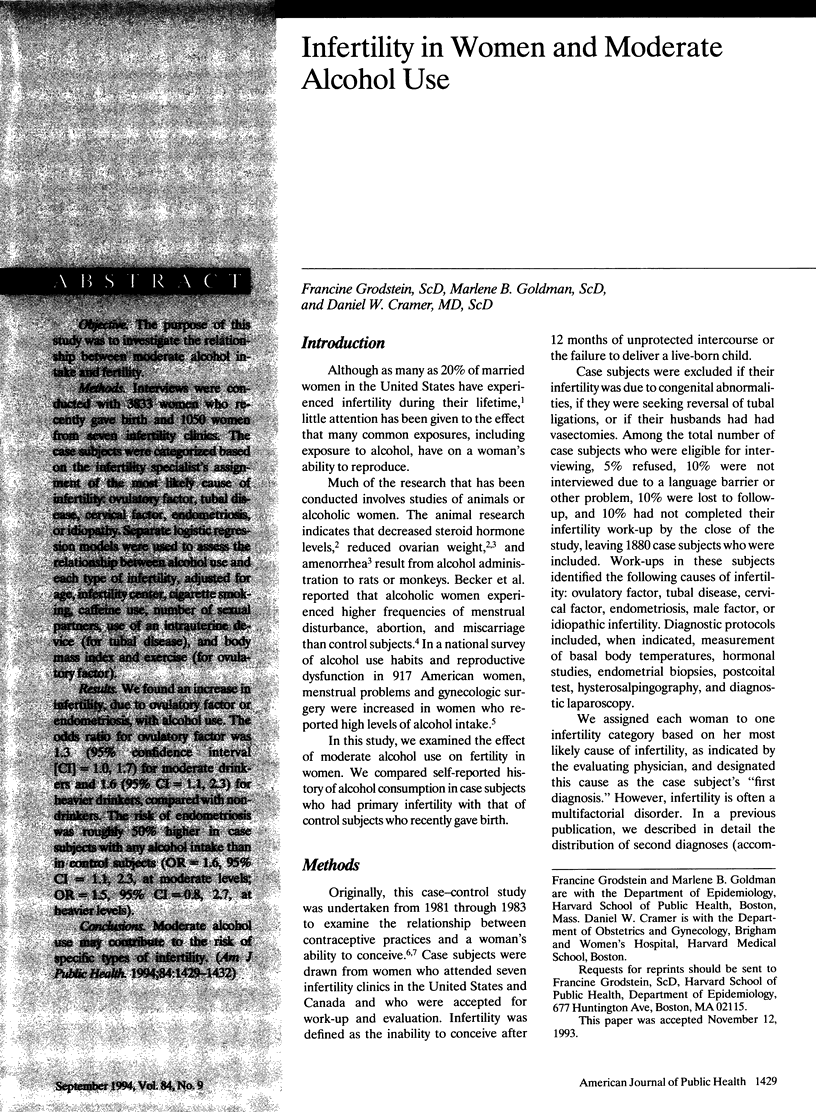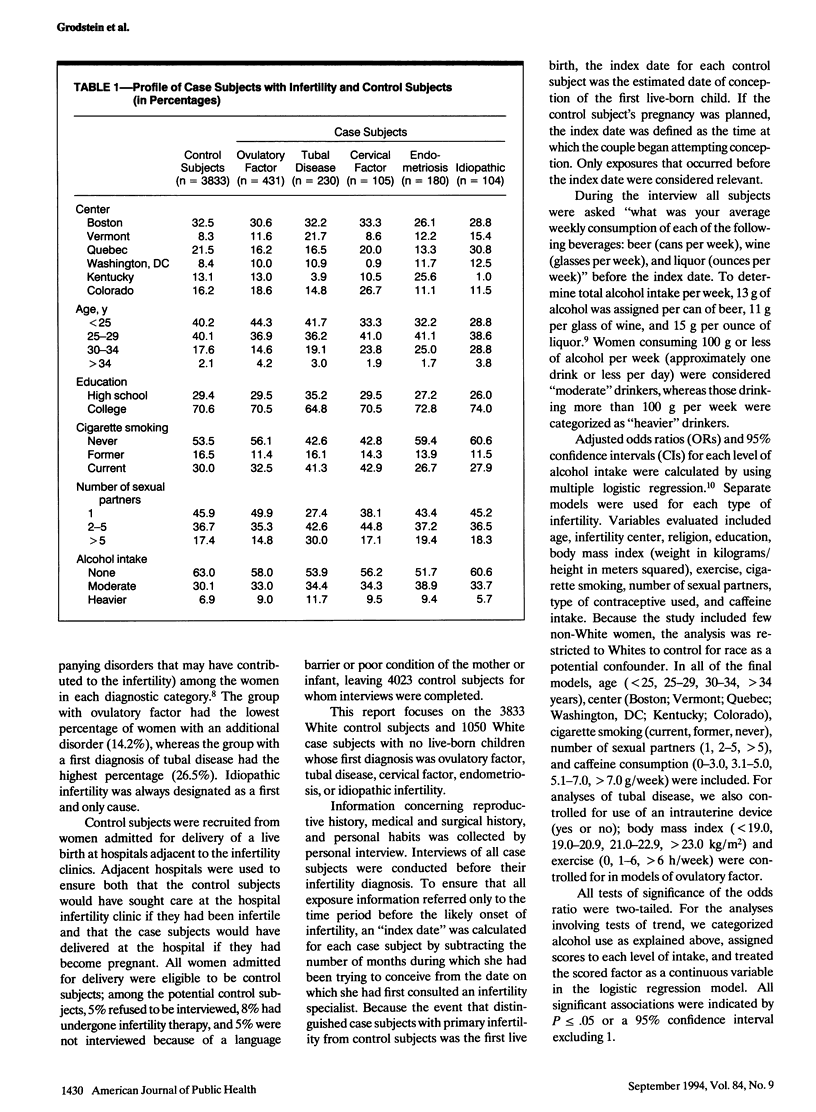Abstract
OBJECTIVE. The purpose of this study was to investigate the relationship between moderate alcohol intake and fertility. METHODS. Interviews were conducted with 3833 women who recently gave birth and 1050 women from seven infertility clinics. The case subjects were categorized based on the infertility specialist's assignment of the most likely cause of infertility: ovulatory factor, tubal disease, cervical factor, endometriosis, or idiopathy. Separate logistic regression models were used to assess the relationship between alcohol use and each type of infertility, adjusted for age, infertility center, cigarette smoking, caffeine use, number of sexual partners, use of an intrauterine device (for tubal disease), and body mass index and exercise (for ovulatory factor). RESULTS. We found an increase in infertility, due to ovulatory factor or endometriosis, with alcohol use. The odds ratio for ovulatory factor was 1.3 (95% confidence interval [CI] = 1.0, 1.7) for moderate drinkers and 1.6 (95% CI = 1.1, 2.3) for heavier drinkers, compared with nondrinkers. The risk of endometriosis was roughly 50% higher in case subjects with any alcohol intake than in control subjects (OR = 1.6, 95% CI = 1.1, 2.3, at moderate levels; OR = 1.5, 95% CI = 0.8, 2.7, at heavier levels). CONCLUSIONS. Moderate alcohol use may contribute to the risk of specific types of infertility.
Full text
PDF



Selected References
These references are in PubMed. This may not be the complete list of references from this article.
- Becker U., Tønnesen H., Kaas-Claesson N., Gluud C. Menstrual disturbances and fertility in chronic alcoholic women. Drug Alcohol Depend. 1989 Aug;24(1):75–82. doi: 10.1016/0376-8716(89)90012-4. [DOI] [PubMed] [Google Scholar]
- Cramer D. W., Goldman M. B., Schiff I., Belisle S., Albrecht B., Stadel B., Gibson M., Wilson E., Stillman R., Thompson I. The relationship of tubal infertility to barrier method and oral contraceptive use. JAMA. 1987 May 8;257(18):2446–2450. [PubMed] [Google Scholar]
- Cramer D. W., Schiff I., Schoenbaum S. C., Gibson M., Belisle S., Albrecht B., Stillman R. J., Berger M. J., Wilson E., Stadel B. V. Tubal infertility and the intrauterine device. N Engl J Med. 1985 Apr 11;312(15):941–947. doi: 10.1056/NEJM198504113121502. [DOI] [PubMed] [Google Scholar]
- Cramer D. W., Wilson E., Stillman R. J., Berger M. J., Belisle S., Schiff I., Albrecht B., Gibson M., Stadel B. V., Schoenbaum S. C. The relation of endometriosis to menstrual characteristics, smoking, and exercise. JAMA. 1986 Apr 11;255(14):1904–1908. [PubMed] [Google Scholar]
- Gavaler J. S., Van Thiel D. H. International Commission for Protection against Environmental Mutagens and Carcinogens. ICPEMC Working Paper No. 15/7. Reproductive consequences of alcohol abuse: males and females compared and contrasted. Mutat Res. 1987 Nov;186(3):269–277. doi: 10.1016/0165-1110(87)90009-1. [DOI] [PubMed] [Google Scholar]
- Grodstein F., Goldman M. B., Ryan L., Cramer D. W. Relation of female infertility to consumption of caffeinated beverages. Am J Epidemiol. 1993 Jun 15;137(12):1353–1360. doi: 10.1093/oxfordjournals.aje.a116644. [DOI] [PubMed] [Google Scholar]
- Hadi H. A., Hill J. A., Castillo R. A. Alcohol and reproductive function: a review. Obstet Gynecol Surv. 1987 Feb;42(2):69–74. [PubMed] [Google Scholar]
- Kelsey J. L. A review of the epidemiology of human breast cancer. Epidemiol Rev. 1979;1:74–109. doi: 10.1093/oxfordjournals.epirev.a036215. [DOI] [PubMed] [Google Scholar]
- Longnecker M. P., Berlin J. A., Orza M. J., Chalmers T. C. A meta-analysis of alcohol consumption in relation to risk of breast cancer. JAMA. 1988 Aug 5;260(5):652–656. [PubMed] [Google Scholar]
- Mello N. K., Bree M. P., Mendelson J. H., Ellingboe J., King N. W., Sehgal P. Alcohol self-administration disrupts reproductive function in female macaque monkeys. Science. 1983 Aug 12;221(4611):677–679. doi: 10.1126/science.6867739. [DOI] [PubMed] [Google Scholar]
- Van Thiel D. H., Gavaler J. S., Lester R. Alcohol-induced ovarian failure in the rat. J Clin Invest. 1978 Mar;61(3):624–632. doi: 10.1172/JCI108973. [DOI] [PMC free article] [PubMed] [Google Scholar]
- Willett W. C., Sampson L., Stampfer M. J., Rosner B., Bain C., Witschi J., Hennekens C. H., Speizer F. E. Reproducibility and validity of a semiquantitative food frequency questionnaire. Am J Epidemiol. 1985 Jul;122(1):51–65. doi: 10.1093/oxfordjournals.aje.a114086. [DOI] [PubMed] [Google Scholar]
- Willett W. C., Stampfer M. J., Colditz G. A., Rosner B. A., Hennekens C. H., Speizer F. E. Moderate alcohol consumption and the risk of breast cancer. N Engl J Med. 1987 May 7;316(19):1174–1180. doi: 10.1056/NEJM198705073161902. [DOI] [PubMed] [Google Scholar]
- Wilsnack S. C., Klassen A. D., Wilsnack R. W. Drinking and reproductive dysfunction among women in a 1981 national survey. Alcohol Clin Exp Res. 1984 Sep-Oct;8(5):451–458. doi: 10.1111/j.1530-0277.1984.tb05700.x. [DOI] [PubMed] [Google Scholar]


